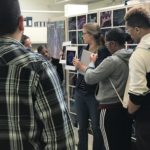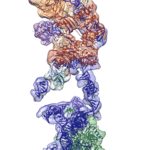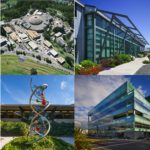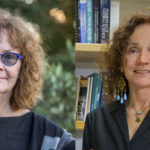Regulation of the enzyme telomerase has been implicated in cancer, other human diseases, and aging, but progress towards therapeutic manipulation of telomerase has been hampered by the lack of high-resolution structural data. Now, researchers in senior faculty scientist Eva Nogales’ lab in Molecular Biophysics and Integrated Bioimaging (MBIB), in collaboration with UC Berkeley professor of Biochemistry, Biophysics and Structural Biology Kathleen Collins, have published a paper in Nature describing the 3-D molecular structure of the human telomerase enzyme.
Strong Biosciences Presence at East Bay STEM Career Awareness Day
 The 7th Annual East Bay STEM Career Awareness Day took place on April 26 at Wareham Development’s Aquatic Park Center in West Berkeley, home to Biosciences Operations @ Berkeley and several Area research groups. The event, organized by the Institute for STEM Education housed at California State University East Bay, had support from Berkeley Lab and several East Bay-based businesses.
The 7th Annual East Bay STEM Career Awareness Day took place on April 26 at Wareham Development’s Aquatic Park Center in West Berkeley, home to Biosciences Operations @ Berkeley and several Area research groups. The event, organized by the Institute for STEM Education housed at California State University East Bay, had support from Berkeley Lab and several East Bay-based businesses.
Biosciences Area FY18 LDRD Projects
The projects of 13 Biosciences Area scientists and engineers received funding through the FY18 Laboratory Directed Research and Development (LDRD) program. These projects span a diverse array of topics and approaches including the study of microbiomes in relation to patterns of mutualism, crop productivity, and gut health; synthetic biology for engineering biosurfactant production and energy conversion pathways; and the application of technologies such as machine learning, high-resolution optical microscopy, and single-cell transcriptomics. Together, these efforts account for 18.75 percent of the $20 million allocated. Lab-wide, 74 projects were selected from a field of 215.
Maxon Addresses Global Bioeconomy Summit 2018
Associate Laboratory Director for Biosciences Mary Maxon joined an international group of policy leaders, NGO, and industry representatives in Berlin last week to discuss the challenges and opportunities associated with shifting from current industry practices to a sustainable bio-based economy. Maxon emphasized the importance of translating basic science to innovation by highlighting the Agile BioFoundry, a national laboratory-led consortium to advance biomanufacturing that is managed by Berkeley Lab.
Chan Zuckerberg Institute Funds Projects in Support of Human Cell Atlas
Two proposals, from Biosciences Area researchers Cynthia McMurray and Carolyn Larabell, have been recommended for funding by the Chan Zuckerberg Initiative (CZI) through a new grant program focused on developing collaborative computational tools to support the Human Cell Atlas (HCA). A global endeavor governed by an organizing committee co-chaired by Aviv Regev at the Broad Institute of MIT and Harvard and Sarah Teichmann at the Wellcome Trust Sanger Institute, the HCA will generate a variety of molecular and imaging data across a range of modalities and spatial scales. To advance the analysis, interpretation, and dissemination of these data, the CZI issued an open call in July 2017 for proposals aimed at creating new computational tools, algorithms, visualizations, and benchmark datasets. After a thorough evaluation process, CZI recommended 85 projects (out of nearly 300 submissions) for funding, and will provide $15 million in total over one year for their execution.
- « Previous Page
- 1
- …
- 124
- 125
- 126
- 127
- 128
- …
- 214
- Next Page »
Was this page useful?







